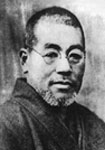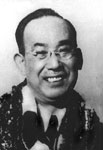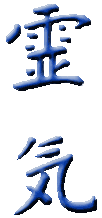
|
The origins
of Reiki can be found in ancient Tibet
thousands of years ago. This knowledge of how to activate a high order
of universal life energy can be traced from Tibet through India. From
India, this knowledge spread into Egypt, Ephesus, Greece and Rome in the
West and into China and, eventually, Japan in approximately the mid-1800's
by a Christian Japanese theologian, Dr.
Mikao Usui.

The legend of Dr. Usui was retold by Hawayo Takata, although Mrs. Takata had never met Dr. Usui since he had died many years before her trip to Japan and introduction to Reiki. At best, it is a third or fourth-hand account containing facts, no doubt dramatically highlighted. The
Legend of Dr. Mikao Usui Dr.Usui (mid 1800's to early 1900's.) was the principal of a Christian seminary in Kyoto, Japan. One Sunday morning, he was questioned very carefully by some graduating seniors as to why they had not been taught how to heal as a part of their missionary training. Having no answers for these questions, Dr. Usui made a decision to resign his position, travel to America, and seek additional knowledge. Returning to Japan, he continued studying and searching for deeper knowledge about the mysteries of life and the use of healing energies. Through the years, Dr. Usui mastered the art of Japanese and Chinese character writing as well as the ancient language of Sanskrit.* After long years of studying and researching, it was in the sutras written in Sanskrit that Dr. Usui discovered keys to activating and directing universal life energy for healing and wholeness. The keys were in the form of a formula-just as plain as mathematics. Nothing difficult but very simple, like 2+2=4. Although Dr. Usui had found keys to activate a higher degree of universal life energy, he also wanted to attain this higher level of contact. He conferred with the head of the monastery in Kyoto where he was staying. It was decided that Dr. Usui would go through a test to validate and attain this power. The next morning he left for Mount Kuriyama, about seventeen miles from Kyoto. Upon this mountain he would meditate and fast for 21 days. In order to keep a calendar of the days, he gathered up 21 stones. Each morning he tossed away one stone. During these days, Dr. Usui also read the sutras, chanted and meditated. Nothing unusual happened. Then, the last
day arrived. "Before sunrise was the darkest...He finished his meditation,
opened his eyes and looked into the dark sky... Then, he saw a flicker
of light and said, "It is happening. "Then, last of all, he saw a great white light and, then, like a screen right in front of him...he saw the Sanskrit he had studied...in golden letters (the words) radiated out in front of him...and he said, "Yes, I remember." It is not known how long this entire process lasted; however, sometime later Dr. Usui gradually returned to normal consciousness - the day had dawned fully! Filled with inspiration
and excitement he jumped to his feet and prepared to go down the mountain.
He realized that he was filled with strength and could walk the distance
back to Kyoto. This was the first miracle. "He dusted off all the
pine needles and dirt...picked up his cane and straw hat and went down
the mountain." In his rush, he stubbed his toe. Later, beginning to feel hungry, he looked for a Japanese style snack bar. "There was a bench with a red blanket means "welcome," please sit, there is a snack bar close by." The old gentleman who owned the snack bar warned Dr. Usui not to eat much food after so long a fast..."he said,"according to your bearded face, it shows that you have been up (up on the mountain) there three weeks"." But, Dr. Usui ordered a full Japanese breakfast anyway! While waiting for the food, the old man's granddaughter came out with some tea for Dr. Usui. "Her face was swollen, and she had a big towel tied up over her head like rabbit ears!" She told Dr. Usui that her tooth had been aching for days but her grandfather could not take her into Kyoto to the dentist- it was too far and he was too poor. Then, Dr. Usui put his hands on the sides oof her swollen face. "The girl began to blink her eyes...she removed the towel, ran to her grandfather and said, "he is no ordinary monk." This was the third miracle! Then Dr. Usui ate a full Japanese breakfast without suffering any indigestion. This was the fourth miracle. Dr. Usui returned to the monastery by evening and shared his discoveries, experiences and knowledge with the Head of the Monastery who was suffering severely from arthritis. Dr. Usui put his hands directly onto the afflicted areas while they were talking. After a few minutes, the old man exclaimed that his pain had stopped and he was filled with energy. In the following days after much discussion and meditating, it was decided that Dr. Usui would go into the Beggar City of Kyoto to help heal the beggars so that they could have new names and begin new lives. He called this process of healing Reiki, a Japanese word meaning universal life force energy. Dressed as a beggar so that he could gain acceptance in Beggar City, Dr. Usui walked into a new cycle of his life which lasted approximately seven years. He treated and healed the sick for many years. "Then, one evening, at twilight, he found himself at leisure. So he walked around the compound." He began to notice that he was seeing some of the very same people that he had healed. He was puzzled. He asked why they had not gone out of the slums and started new lives. They explained to him that it was just too hard to work for a living - it was easier to remain beggars. Now Dr. Usui "received the greatest shock of his life...he just threw himself to the ground." He felt that he had failed in his work - that he had forgotten to teach them gratitude. He remained in depression for several days. The five Reiki principles were formulated at this time. He realized that if "he had taught them this spiritual side of it first, and then healed the body, he would have been a success." Soon he left Beggar City. Dr. Usui returned to Kyoto. The next day he went to a public market place, lit a large torch and began walking up and down. Many people passed by him laughing at this strange sight. Finally, one young man approached Dr. Usui asking, "Why do you need such a torch on a beautiful, sunny day? It is easy to see today. "Dr. Usui agreed, then added, "that he was searching for people who wanted to see the real light - for people who are ill and depressed and wanted to be relieved of these miseries." He announced that he would give a lecture that evening for those who wanted to hear about Reiki. Thus began Dr. Usui's life of traveling, lecturing and teaching Reiki throughout Japan. |
||
|
Before the end of his life, Dr. Usui had taught Reiki to many people and had shared the inner knowledge of Reiki with sixteen close and advanced students. One of these men was Dr. Jujiro Hayashi who continued Dr. Usui's Reiki tradition traveling, teaching, and dedicating his life to Reiki after Dr. Usui past on around 1893. A member of the Japanese aristocracy, Dr. Hayashi, ran his private Reiki clinic in Tokyo until 1940. He trained two Japanese women. One of these teachers stayed in Japan; the other, Mrs. Hawayo Takata of Hawaii, was made a Reiki Master in 1938. |
 |
|
 "Hawayo
Takata was born in the Hawaiian Islands, one of several children of
a plantation orker. She was named "Hawayo" in honor of the entire
Island group. Although born of Japanese parents, Hawayo was entitled to
U.S. citizenship due to the place of her birth. "Hawayo
Takata was born in the Hawaiian Islands, one of several children of
a plantation orker. She was named "Hawayo" in honor of the entire
Island group. Although born of Japanese parents, Hawayo was entitled to
U.S. citizenship due to the place of her birth.
She recalled having worked in the cane fields as a small child and she remembered having gone only to the second or third grade. Then she was asked to work in the main plantation house. Through the years, she was given increased duties and eventually was put in charge of the other household staff She married the family accountant, a young man also of Japanese descent. In his late twenties her husband died of a heart attack. Hawayo was left with two young daughters. In the mid-1930's with failing health, she took her children and went to her parents' home in Japan "to prepare to die". Her physical health had been draining her energy. She was suffering from lung problems, heart problems, stomach disorders and a bad gall bladder. At her parent's, she was able to rest and after a few months prepared to under go surgery. However, just before the scheduled operation was about to begin she heard her husband's voice saying emphatically, "No surgery, No surgery." She noted that only a few times throughout her entire life, in very important matters she would hear her husband's voice-this was one of those crucial times. Immediately, she refused surgery. Her doctor then referred her to a Reiki natural healing clinic in Tokyo. On a daily basis, Mrs. Takata received a complete Reiki treatment at this clinic. After approximately eight months, her health was fully restored. In addition, this experience with the power of Reiki transformed her life. She desired to learn Reiki in order to help others. At first she was told that she could not learn Reiki, she was a woman and not a citizen of Japan. However, she continued helping out with chores and errands at the Reiki clinic and before long was taught First and Second Degree Reiki. In about 1938, Hawayo was trained by Dr. Hyashi as a Reiki Master before returning with her daughters to her home of Hawaii. For many Years, Hawayo Takata traveled in the Islands teaching Reiki and giving treatments. Mrs. Takata was instrumental in spreading the teachings of Reiki to the United States of America . |
||
 |